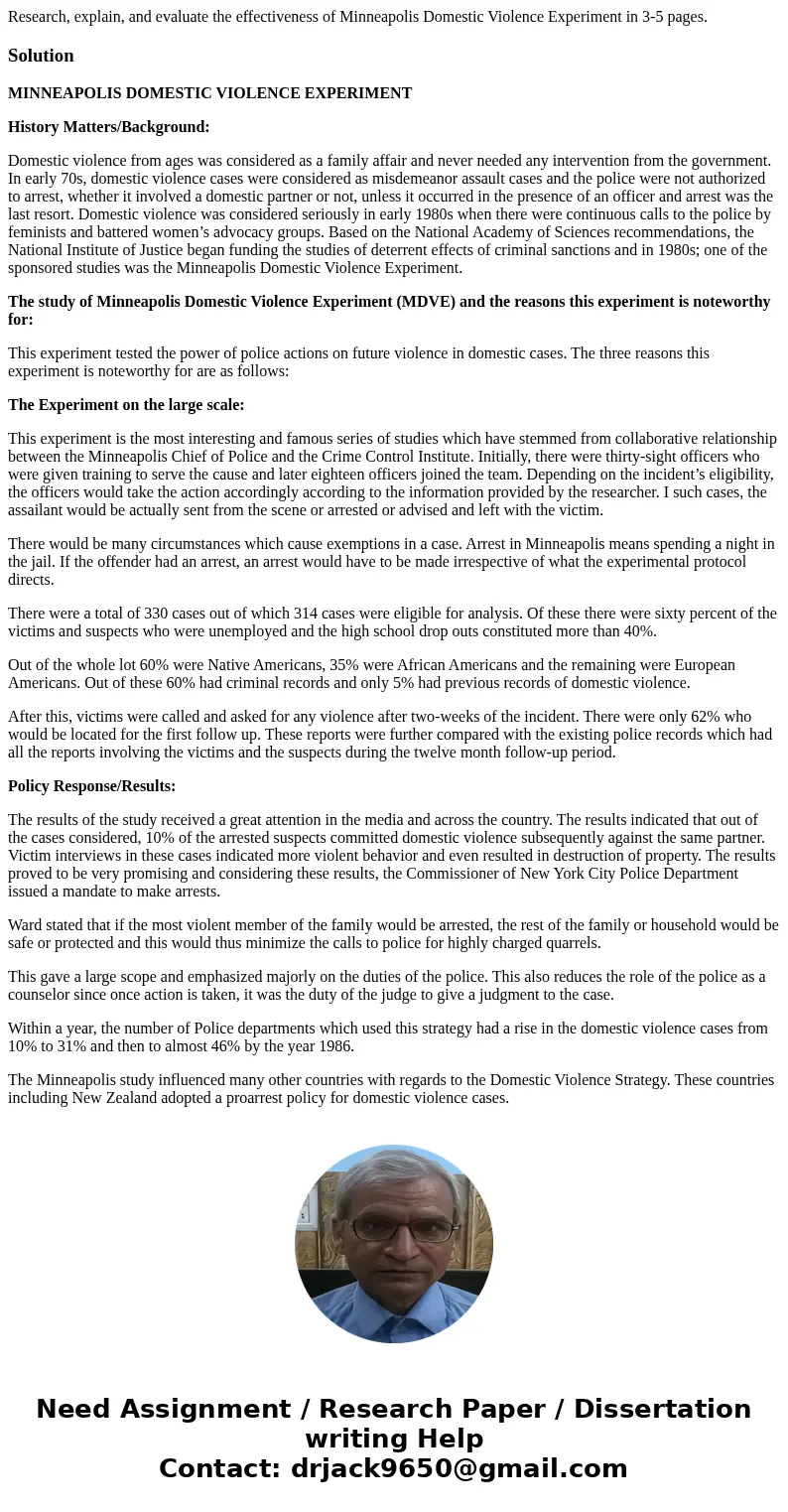Research explain and evaluate the effectiveness of Minneapol
Research, explain, and evaluate the effectiveness of Minneapolis Domestic Violence Experiment in 3-5 pages.
Solution
MINNEAPOLIS DOMESTIC VIOLENCE EXPERIMENT
History Matters/Background:
Domestic violence from ages was considered as a family affair and never needed any intervention from the government. In early 70s, domestic violence cases were considered as misdemeanor assault cases and the police were not authorized to arrest, whether it involved a domestic partner or not, unless it occurred in the presence of an officer and arrest was the last resort. Domestic violence was considered seriously in early 1980s when there were continuous calls to the police by feminists and battered women’s advocacy groups. Based on the National Academy of Sciences recommendations, the National Institute of Justice began funding the studies of deterrent effects of criminal sanctions and in 1980s; one of the sponsored studies was the Minneapolis Domestic Violence Experiment.
The study of Minneapolis Domestic Violence Experiment (MDVE) and the reasons this experiment is noteworthy for:
This experiment tested the power of police actions on future violence in domestic cases. The three reasons this experiment is noteworthy for are as follows:
The Experiment on the large scale:
This experiment is the most interesting and famous series of studies which have stemmed from collaborative relationship between the Minneapolis Chief of Police and the Crime Control Institute. Initially, there were thirty-sight officers who were given training to serve the cause and later eighteen officers joined the team. Depending on the incident’s eligibility, the officers would take the action accordingly according to the information provided by the researcher. I such cases, the assailant would be actually sent from the scene or arrested or advised and left with the victim.
There would be many circumstances which cause exemptions in a case. Arrest in Minneapolis means spending a night in the jail. If the offender had an arrest, an arrest would have to be made irrespective of what the experimental protocol directs.
There were a total of 330 cases out of which 314 cases were eligible for analysis. Of these there were sixty percent of the victims and suspects who were unemployed and the high school drop outs constituted more than 40%.
Out of the whole lot 60% were Native Americans, 35% were African Americans and the remaining were European Americans. Out of these 60% had criminal records and only 5% had previous records of domestic violence.
After this, victims were called and asked for any violence after two-weeks of the incident. There were only 62% who would be located for the first follow up. These reports were further compared with the existing police records which had all the reports involving the victims and the suspects during the twelve month follow-up period.
Policy Response/Results:
The results of the study received a great attention in the media and across the country. The results indicated that out of the cases considered, 10% of the arrested suspects committed domestic violence subsequently against the same partner. Victim interviews in these cases indicated more violent behavior and even resulted in destruction of property. The results proved to be very promising and considering these results, the Commissioner of New York City Police Department issued a mandate to make arrests.
Ward stated that if the most violent member of the family would be arrested, the rest of the family or household would be safe or protected and this would thus minimize the calls to police for highly charged quarrels.
This gave a large scope and emphasized majorly on the duties of the police. This also reduces the role of the police as a counselor since once action is taken, it was the duty of the judge to give a judgment to the case.
Within a year, the number of Police departments which used this strategy had a rise in the domestic violence cases from 10% to 31% and then to almost 46% by the year 1986.
The Minneapolis study influenced many other countries with regards to the Domestic Violence Strategy. These countries including New Zealand adopted a proarrest policy for domestic violence cases.
The policy response and the publicity had generated a considerable debate among the researchers and also highlighted the need for replication.
The Minneapolis Domestic Violence Experiment was the first Police policy that provided perfect statistically significant evidence. This experiment has been very helpful in raising public awareness of domestic violence and prompted the police to reconsider their long-held assumptions. One of the legacies of the Minneapolis has been a sustained effort to address the problem very effectively and has set an example to the whole world. There were many policy changes later and revisions.


 Homework Sourse
Homework Sourse